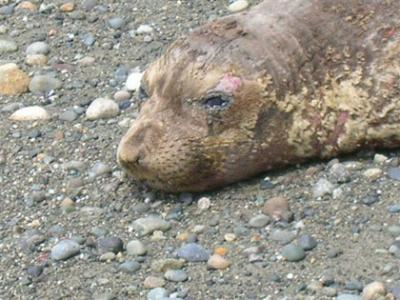
Phantom Fins

One afternoon in early March, Miss Nashoba the jumpin’ Jack Russell took her two-leggeds for a romp along the beach. We spied Neil the Seal and his swim buddy clinging to shore, cruising east but casting frequent glances westward. The seals did not look relaxed. Hmm, Ides of March with nervous Harbor seals.
A binocular scan quickly revealed the source of their apprehension: orca blows off Gig Harbor. In hazy glare, the blows appeared spectral and virtually disembodied from eight Transient killer whales: one male and the rest females and juveniles. Too distant and indistinct to identify individually, the Phantom Fins disappeared within minutes, down Colvos Pass into the Narrows. Consistent with our Indigenous ancestral traditions, the natural world provided the only clues to the orcas’ presence on March 8 – venerable wisdom gleaned from SealBook, ha ha!
In the last decade, Vashon-Maury has typically had several killer whale visits in February and March. 2013 was different, with all manner of porpoises -- Dall’s, Harbor, hybrids – and Harbor seals, but just one confirmed Vashon orca sighting in March. Seals are hauling out on our beaches; be considerate and steer clear of the resting cuties. At Chez VHP, we modify Miss Nashoba’s bedtime constitutional to avoid disturbing the seals who relax on "her" beach at night.
The unhappy camper in this week’s photo is a molting Northern Elephant seal. Sometimes Elephant seals visit Vashon-Maury in spring, and their molting process requires a lengthy period ashore. Call the VHP if an Elephant seal lands on a beach near you. For the sake of our seals and all critters, read on to learn the proper way to report a spill.
After the destructive 2004 Dalco Pass oil spill, VHP partners along with a handful of Islanders attended spill training and beach cleaning for first responders. Inculcated in us was where and how to report a spill, as well as the urgency of initiating a competent cleanup effort by agencies with essential skills and equipment.
We all know to call 911 instantly to report a house on fire. The house on fire for our marine wildlife is a toxic spill of oil or other contaminants. Every Islander should know what to do immediately upon discovering a suspicious substance on a beach or in our waters – call the Washington State Department of Ecology (DOE) at 1-800-OILS-911 (1-800-645-7911). In addition, report all spills of oil or hazardous materials to the National Response Center at 1-800-424-8802.
Evidently, lessons from the 2004 spill have faded. Diffusion of responsibility and delayed response time were huge impediments to effective containment of the Dalco Pass spill. It quickly spread into Colvos Pass and as far north as Bainbridge Island. An oiled seal pup died; several oiled birds were cleaned. Folks new to Vashon will find numerous articles archived online about the 2004 spill, ultimately traced to the Polar Texas oil tanker.
The marine lubricant mess on Maury Island in early March was not as dire as the 2004 spill, but it should jolt us out of complacency. Once informed of the gunk on Maury, DOE executed a timely, laudable response. However, the convoluted notification of DOE regarding the incident was alarming. Lack of awareness about emergency numbers for reporting spills and mysterious beach slime poses a risk to the Island. In a catastrophic spill, failure to report swiftly and directly would prove deadly. Minutes matter for wildlife in harm’s way. Our animal neighbors depend on us to react judiciously in a toxic crisis.
Please support the work of the Vashon Hydrophone Project (VHP): REPORT LOCAL WHALE SIGHTINGS ASAP TO 463-9041, as well as sick, injured, or dead marine mammals on Island beaches. Reporting directly to the VHP expedites the crucial sample collection effort of our esteemed associate, researcher Mark Sears, and sustains an accurate dataset of whale sightings for Vashon-Maury and Central Puget Sound waters, initiated three decades ago by Mark. Check for updates at Vashonorcas.org and send photos to Orca Annie at Vashonorcas@aol.com.
- Login to post comments
